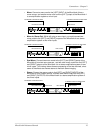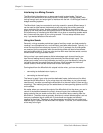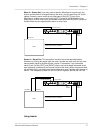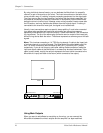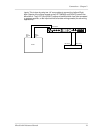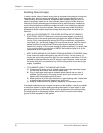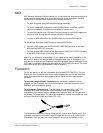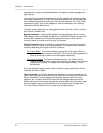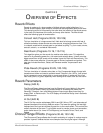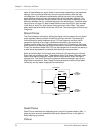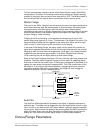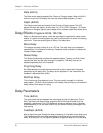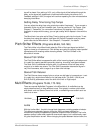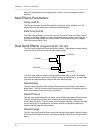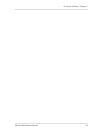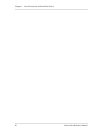
Overview of Effects – Chapter 3
MicroVerb 4 Reference Manual 23
CHAPTER 3
OVERVIEW OF EFFECTS
Reverb Effects
Reverb is made up of a large number of distinct echoes, called reflections. In a
natural acoustic space, each reflection’s amplitude and brightness decays over time.
This decaying action is influenced by the room size, the location of the sound source
in the room, the hardness of the walls, and many other factors. The MicroVerb 4
offers the following types of reverberation:
Concert Hall (Programs 00-09, 100-109)
This is a simulation of a large concert hall. Halls tend to be large rooms with lots of
reflective surfaces, where sounds can swim around, changing timbre over time. This
is a classic reverb which sounds good on just about anything. Try it on vocals, drums,
acoustic, electric, or orchestral instruments.
Real Room (Programs 10-19, 110-119)
This algorithm gives you the sound of a medium size studio room. This algorithm
uses a lot of processing power for a rich sound and smooth decay. It has a punchier,
bigger sound than a Hall reverb, which makes it good for Rock and Dance music. The
attack is also more reflective. It sounds good on drums, keyboards and guitars. This
type also includes Nonlinear, Gated, and Reverse reverbs. for percussion and
effects.
Plate Reverb (Programs 20-29, 120-129)
This is a simulation of a classic echo plate, a 4' by 8' suspended sheet of metal with
transducers at either end used to produce reverb. Popular in the 1970’s, it still prized
for its transparent sound, particularly on vocals and guitars. It works well for a lush
lead vocal, piano, or guitar, especially when looking for a classic rock and roll sound.
Reverb Parameters
Decay (Edit A)
The Reverb Decay determines how long the Reverb will sound before it dies away.
Turning up the Reverb Decay will have the effect of increasing the rooms size.
Generally, Classical, Jazz, and Ballad styles will use longer decay times than Up
tempo Rock or Dance music. The LCD display will show the Decay time in Seconds
and Milliseconds.
Hi Cut (Edit B)
The Hi Cut filter can be set between 059 Hz and 36.2 kHz or OFF, and attenuates all
frequencies above this value by 6dB per octave. The lower the setting, the less high
frequencies of the input are allowed to pass thru to the reverb effect. This controls the
overall character of the room. Try a brighter sound on vocals, drums, and percussion,
and a darker sound (i.e. lower Hi Cut frequency) on Acoustic Guitar, Piano, and
Strings.
Chorus/Flange Effects (Programs 30-49, 130-149)
The Chorus and Flange effects alter the pitch and delay of a signal in various ways to
produce “layered” timbres that are more complex than the original signal. Although



